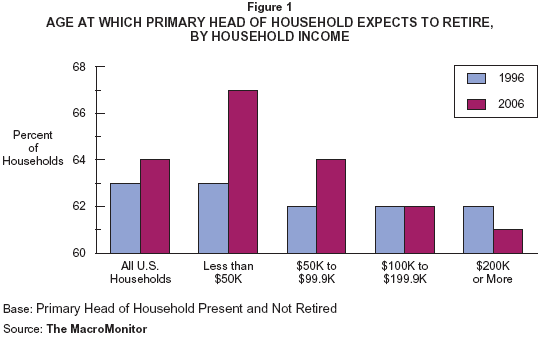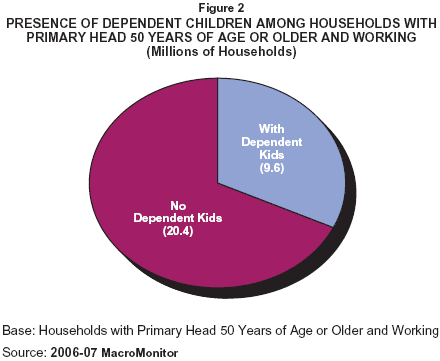MacroMonitor Market Trends July 2008
MacroMonitor Market Trends highlights topical news and trends of interest to you and your colleagues. If you would like more information about the items in the newsletter or would like to discuss other ways that we can assist you in your research and marketing efforts, please contact us.
In this issue:
Retirement Age Grows Older
During the past decade in the United States, the age at which the primary head of household expects to retire has increased, particularly among lower-income households. According to the MacroMonitor, the average age at which the primary head expects to retire has crept up by one year, from 63 years in 1996 to 64 years in 2006. Among households with an income of less than $50,000, however, the expected age of retirement for the primary head has jumped by four years, from 63 years in 1996 to 67 years in 2006.
Middle-income households likewise are not immune to this less-optimistic future. In 2006, the age at which the primary head expects to retire is 64 years, in comparison with 62 years a decade ago. In contrast, among the affluent, the average expected age of retirement remained unchanged during the ten-year period and has even gone down among the wealthier households—from 62 years to 61 years among primary heads of households with an income of at least $200,000.
Other studies, such as the recent AARP survey of U.S. adults ages 45 years and older, similarly note a trend in people's putting retirement on hold as a result of the current dire economic circumstances. For the immediate future, increasing numbers of household heads appear to face the possibility of never being able to retire at all.

"Full Nest" Adds Strain to Retirement Planning
One of the major social trends reshaping the consumer-financial-services landscape is the continued presence of children in the home even as the primary head of household nears retirement. In 2006, nearly one-third of households with a working primary head age 50 years or older have one or more dependent children. And 30% of these 50+ working households with dependent children have at least one child still younger than 12 years of age.
In addition to having kids at a later age, 50+ working households face the increased prospect of having their older children return home. The 2006–07 MacroMonitor reports that nearly one in ten working 50+ nonretired households had an adult child return to the household. Monstertrak's recent survey of college students and recent graduates similarly noted that more of its respondents report spending more time back at home than they initially anticipated, citing limited financial resources as their reason.
The financial impact of a "full nest" at the stage in life when one expects the household focus to be on the sprint to retirement is not inconsequential. The possibility of having no option but to retire at a later date than they initially planned is certainly on the table for these full-nest households.

Workers Learn to Diversify from Company Stock
Thousands of workers lost their retirement savings after the collapse of Enron and WorldCom and the dissolution of Arthur Andersen in 2002. Early in 2008, Bear Stearns employees, who owned an estimated one-third of the financial institution's shares, similarly experienced a virtual wipeout of their retirement savings. And now, the wisdom of owning large shares of company stock is haunting workers at Freddie Mac and Fannie Mae, with Freddie Mac shares recently falling 88% from their 2006 high and Fannie Mae's stock down 85% from its peak in 2007.
Despite these high-profile cases, employees in general seem to have learned their lesson from the Enron debacle. The MacroMonitor estimates that as of 2006, just 12% of 401(k) and other salary-reduction–plan owners are invested in the company stock of their current or former employers. This situation is a far cry from the one in 2002, when 36% of plan owners had company stock in their retirement portfolio. Among Gen X/Y workers, the incidence of their owning company stock in 2002 was even higher: 39%. Now, a more modest 13% of Gen X/Y workers are invested in company stock. Among the working cohorts, Younger Boomers are the most likely to own company stock in their retirement plan: 15% in 2006, which is a much more conservative participation rate than that in 2002, when roughly one-third owned company stock in their portfolio.
